
Railway pay cheques were metallic tokens or tallies used to ensure appropriate payment to the correctly identified railway employee.

Railway pay cheques were metallic tokens or tallies used to ensure appropriate payment to the correctly identified railway employee.
The one-sided identification cheques were usually drawn from the wages office on a Thursday, prior to the Friday payday. The cheques would then be exchanged for a payslip, and the wages paid on signature. [1] In many cases where pay cheques were in use they were often issued to each employee at the start of his employment and retained for the rest of the person's working life with the company. [2] Specialised trays were used for storing these cheques. [3] Stores, maintenance and other departments used this 'pay cheque' system. British Railways examples exist, however it is not at present recorded when their use ceased. [4]
Other occupations used the pay cheque system, such as the mining industry. [2]

These had a slightly different use, being more of a system for ensuring the correct pay by 'checking' in and out of the workplace prior to machines being produced for this specific purpose. 'Checks' were often 'holed' for hanging on boards. In mining, for example, a number on the check was personal to each miner and prior to going down the pit, the miner would give one of his tallies to the pit head "banksman", keeping the duplicate for the duration of the shift. Upon returning to the surface, the miner gave his personal tally to the banksman who would pass it on to the time office or the lamp room. This system made it possible to keep track on workers' whereabouts in the mine complex and for what periods they were working. [5]
Pay checks and tallies were only marked on one side and were produced in a great variety of shapes, sizes and designs; made typically of brass or zinc, sometimes steel or aluminium. [5]

Pay cheques came in various shapes and sizes, including oval, circular, square, tear-shaped, D-shaped, bone-shaped, rectangular, [4] octangular, [6]
Copper, brass, white metal [4] and pewter were in common use. [7]
Pay cheques were issued by a number of companies, including the Great Western Railway, London, Midland and Scottish Railway, London & North Western Railway, British Railways, [4] Great Central Railway, [8] North Eastern Railway, [9] etc.
Railway cheques are collected as exonumia or paranumismatica. [3]
Cheque clearing or bank clearance is the process of moving cash from the bank on which a cheque is drawn to the bank in which it was deposited, usually accompanied by the movement of the cheque to the paying bank, either in the traditional physical paper form or digitally under a cheque truncation system. This process is called the clearing cycle and normally results in a credit to the account at the bank of deposit, and an equivalent debit to the account at the bank on which it was drawn, with a corresponding adjustment of accounts of the banks themselves. If there are not enough funds in the account when the cheque arrived at the issuing bank, the cheque would be returned as a dishonoured cheque marked as non-sufficient funds.
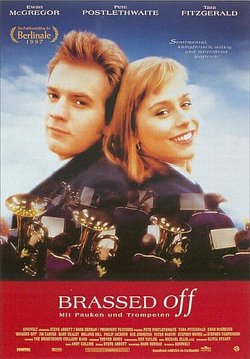
Brassed Off is a 1996 British comedy-drama film written and directed by Mark Herman and starring Pete Postlethwaite, Tara Fitzgerald and Ewan McGregor.
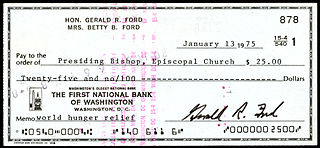
A cheque, or check, is a document that orders a bank to pay a specific amount of money from a person's account to the person in whose name the cheque has been issued. The person writing the cheque, known as the drawer, has a transaction banking account where the money is held. The drawer writes various details including the monetary amount, date, and a payee on the cheque, and signs it, ordering their bank, known as the drawee, to pay the amount of money stated to the payee.
The Three-Day Week was one of several measures introduced in the United Kingdom in 1973–1974 by Edward Heath's Conservative government to conserve electricity, the generation of which was severely restricted owing to industrial action by coal miners and railway workers.
Burnbank is an area in the town of Hamilton, South Lanarkshire, Scotland. It was formerly a separate mining village before being absorbed into the town.
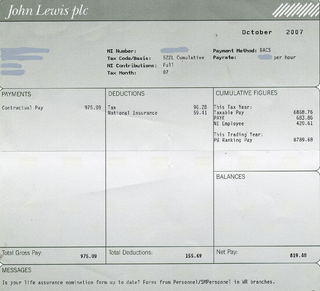
A paycheck, also spelled paycheque, pay check or pay cheque, is traditionally a paper document issued by an employer to pay an employee for services rendered. In recent times, the physical paycheck has been increasingly replaced by electronic direct deposits to the employee's designated bank account or loaded onto a payroll card. Employees may still receive a pay slip to detail the calculations of the final payment amount.
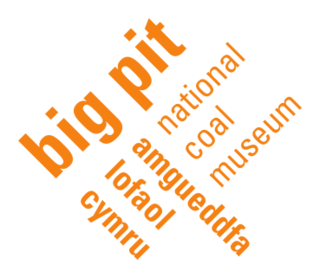
Big Pit National Coal Museum is an industrial heritage museum in Blaenavon, Torfaen, Wales. A working coal mine from 1880 to 1980, it was opened to the public in 1983 as a charitable trust called the Big Pit (Blaenavon) Trust. By 1 February 2001 Big Pit Coal Museum was incorporated into the National Museums and Galleries of Wales as the National Mining Museum of Wales. The site is dedicated to operational preservation of the Welsh heritage of coal mining, which took place during the Industrial Revolution.
The Miners' Federation of Great Britain (MFGB) was established after a meeting of local mining trade unions in Newport, Wales in 1888. The federation was formed to represent and co-ordinate the affairs of local and regional miners' unions in England, Scotland and Wales whose associations remained largely autonomous. At its peak, the federation represented nearly one million workers. It was reorganised into the National Union of Mineworkers in 1945.
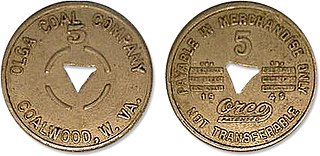
Company scrip is scrip issued by a company to pay its employees. It can only be exchanged in company stores owned by the employers. In the United Kingdom, such truck systems have long been formally outlawed under the Truck Acts. In the United States, payment in scrip became illegal in 1938 as part of the Fair Labor Standards Act.
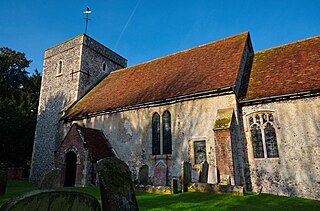
Tilmanstone is a small village and civil parish in Kent, in the South East of England, near Eastry, a much bigger and more developed area. Tilmanstone no longer has a village school; however, the independent Northbourne Park School is close to the parish boundary. The name of Tilmanstone has historically been famous for its colliery, although it is located in the village of Eythorne, operated from 1906 to 1986 as one of the four main pits of the Kent coalfield. The population taken at the 2011 Census also included that of the nearby hamlet of Ashley.
The South Yorkshire Coalfield is so named from its position within Yorkshire. It covers most of South Yorkshire, West Yorkshire and a small part of North Yorkshire. The exposed coalfield outcrops in the Pennine foothills and dips under Permian rocks in the east. Its most famous coal seam is the Barnsley Bed. Coal has been mined from shallow seams and outcrops since medieval times and possibly earlier.

Ballingarry Coal Mines are underground coal mines located near the village of Ballingarry, County Tipperary, Ireland. Situated near the border with County Kilkenny, the mines are now disused and have flooded. Other nearby centres of population are Killenaule and New Birmingham.

Chatterley Whitfield Colliery is a disused coal mine on the outskirts of Chell, Staffordshire in Stoke on Trent, England. It was the largest mine working the North Staffordshire Coalfield and was the first colliery in the UK to produce one million tons of saleable coal in a year.
In financial transactions, a warrant is a written order by one person that instructs or authorises another person to pay a specified recipient a specific amount of money or supply goods at a specific date. A warrant may or may not be negotiable and may be a bearer instrument that authorises payment to the warrant holder on demand or after a specific date. Governments and businesses may pay wages and other accounts by issuing warrants instead of cheques.

Hatfield Colliery, also known as Hatfield Main Colliery, was a colliery in the South Yorkshire Coalfield, mining the High Hazel coal seam. The colliery was around 1 mile (1.6 km) northwest of Hatfield, South Yorkshire, adjacent north of the railway line from Doncaster to Scunthorpe northeast of Hatfield and Stainforth railway station.

The Lancashire Coalfield in North West England was an important British coalfield. Its coal seams were formed from the vegetation of tropical swampy forests in the Carboniferous period over 300 million years ago.

Markham Main Colliery was a coal mine in Armthorpe, on the eastern edge of Doncaster, South Yorkshire, England. It could be seen, and was a landmark, from the nearby M18.
The Tarenni Colliery and its associated workings, are a series of coal mines and pits located between the villages of Godre'r Graig and Cilybebyll located in the valley of the River Tawe, in Neath Port Talbot county borough, South Wales.
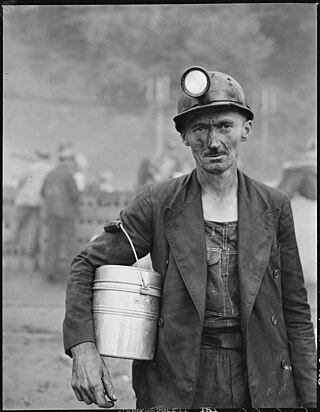
People have worked as coal miners for centuries, but they became increasingly important during the Industrial revolution when coal was burnt on a large scale to fuel stationary and locomotive engines and heat buildings. Owing to coal's strategic role as a primary fuel, coal miners have figured strongly in labor and political movements since that time.

Pulpería was the name given to company stores and dining facilities in parts of South America, notably in the industries that extracted sodium nitrate from caliche deposits between 1850 and 1930 in Northern Chile in the current regions of Tarapaca and Antofagasta. The term was used in the Spanish colonial period in South America.